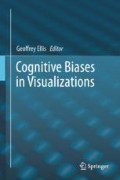Abstract
Exploratory data analysis involves making a series of complex decisions: what should I explore? what questions should I ask? As users do not have good knowledge about the data they are exploring, making these decisions is non-trivial. In making these decisions, heuristics are often applied, potentially causing a biased exploration path. While breadth-oriented data exploration presents a promising solution to rectifying a biased exploration path, how to design such systems is yet to be explored. In this Chapter, we propose three considerations in designing systems that support breadth-oriented data exploration. To demonstrate the utility of these design considerations, we describe a hypothetical breadth-oriented system. We argue that these design considerations pave the way for understanding how breadth-oriented exploration mitigates biases in exploratory data analysis.
Access this chapter
Tax calculation will be finalised at checkout
Purchases are for personal use only
References
Chau DH, Kittur A, Hong JI, Faloutsos C (2011) Apolo: making sense of large network data by combining rich user interaction and machine learning. In: Proceedings of the SIGCHI conference on human factors in computing systems, ACM, pp 167–176
Dheeru D, Karra Taniskidou E (2017) UCI machine learning repository. http://archive.ics.uci.edu/ml/datasets/auto+mpg
Gotz D, Sun S, Cao N (2016) Adaptive contextualization: combating bias during high-dimensional visualization and data selection. In: Proceedings of the 21st international conference on intelligent user interfaces, ACM, pp 85–95
Kairam S, Riche NH, Drucker S, Fernandez R, Heer J (2015) Refinery: visual exploration of large, heterogeneous networks through associative browsing. Comput Graphics Forum, Wiley Online Library 34:301–310
Nickerson RS (1998) Confirmation bias: a ubiquitous phenomenon in many guises. Rev Gen Psych 2(2):175
O’malley AJ, Arbesman S, Steiger DM, Fowler JH, Christakis NA (2012) Egocentric social network structure, health, and pro-social behaviors in a national panel study of americans. PLoS One 7(5):e36,250
Perer A, Shneiderman B (2008) Systematic yet flexible discovery: Guiding domain experts through exploratory data analysis. In: Proceedings of the 13th international conference on intelligent user interfaces, ACM, pp 109–118
Sarvghad A, Tory M, Mahyar N (2017) Visualizing dimension coverage to support exploratory analysis. IEEE Trans Visualization Comput Graphics 23(1):21–30
Toms EG (2002) Information interaction: providing a framework for information architecture. J Assoc Inf Sci Technol 53(10):855–862
Tversky A, Kahneman D (1973) Availability: a heuristic for judging frequency and probability. Cognitive Psychology 5(2):207–232
Tversky A, Kahneman D (1974) Judgment under uncertainty: heuristics and biases. Science 185(4157):1124–1131
Van Ham F, Perer A (2009) ?search, show context, expand on demand?: Supporting large graph exploration with degree-of-interest. IEEE Trans Visualization Comput Graphics 15(6)
Willett W, Heer J, Agrawala M (2007) Scented widgets: improving navigation cues with embedded visualizations. IEEE Trans Visualization Comput Graphics 13(6):1129–1136
Wongsuphasawat K, Moritz D, Anand A, Mackinlay J, Howe B, Heer J (2016) Voyager: exploratory analysis via faceted browsing of visualization recommendations. IEEE Trans Visualization Comput Graphics 22(1):649–658
Author information
Authors and Affiliations
Corresponding author
Editor information
Editors and Affiliations
Rights and permissions
Copyright information
© 2018 Springer Nature Switzerland AG
About this chapter
Cite this chapter
Law, PM., Basole, R.C. (2018). Designing Breadth-Oriented Data Exploration for Mitigating Cognitive Biases. In: Ellis, G. (eds) Cognitive Biases in Visualizations. Springer, Cham. https://doi.org/10.1007/978-3-319-95831-6_11
Download citation
DOI: https://doi.org/10.1007/978-3-319-95831-6_11
Published:
Publisher Name: Springer, Cham
Print ISBN: 978-3-319-95830-9
Online ISBN: 978-3-319-95831-6
eBook Packages: Computer ScienceComputer Science (R0)

